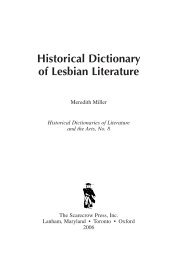Founded by Friends : the Quaker heritage of fifteen - Scarecrow Press
Founded by Friends : the Quaker heritage of fifteen - Scarecrow Press
Founded by Friends : the Quaker heritage of fifteen - Scarecrow Press
Create successful ePaper yourself
Turn your PDF publications into a flip-book with our unique Google optimized e-Paper software.
xx Thomas D. Hamm<br />
and justice. Yet one does not see this in <strong>the</strong> history <strong>of</strong> <strong>Quaker</strong> colleges.<br />
Haverford did not admit a black student until <strong>the</strong> 1920s, Swarthmore until<br />
<strong>the</strong> 1940s, and Wilmington until <strong>the</strong> 1950s. Guilford deferred to local<br />
segregationist mores until <strong>the</strong> 1960s. Even colleges like Earlham, which<br />
admitted its first black student in <strong>the</strong> 1880s, <strong>of</strong>ten reflected <strong>the</strong> prevalent<br />
racism <strong>of</strong> <strong>the</strong> larger society in o<strong>the</strong>r ways. In many respects, <strong>the</strong> best early<br />
record may have been that <strong>of</strong> Malone, whose color-blindness as early as<br />
<strong>the</strong> 1890s was striking. By <strong>the</strong> 1960s, however, a commitment to <strong>the</strong> civil<br />
rights movement was seen as one <strong>of</strong> <strong>the</strong> distinguishing marks <strong>of</strong> a <strong>Quaker</strong><br />
college, and campuses like Earlham, Haverford, and Swarthmore were<br />
centers <strong>of</strong> activism and support for it.<br />
Ano<strong>the</strong>r test might be commitment to gender equality. Only Haverford<br />
and Bryn Mawr were founded as men’s and women’s colleges. The rest<br />
were committed to coeducation. With <strong>the</strong> exception <strong>of</strong> Haverford, all <strong>the</strong><br />
<strong>Quaker</strong> colleges early hired women as faculty members. On <strong>the</strong> o<strong>the</strong>r<br />
hand, one sees relatively little women’s rights activism on <strong>the</strong>ir campuses<br />
before <strong>the</strong> 1960s, save at Swarthmore and, <strong>of</strong> course, Bryn Mawr. And<br />
with <strong>the</strong> natural exception <strong>of</strong> Bryn Mawr, only a few <strong>of</strong> <strong>the</strong>se colleges<br />
have had a woman president.<br />
Yet ano<strong>the</strong>r mark <strong>of</strong> <strong>Quaker</strong> distinctiveness might be a common commitment<br />
to <strong>the</strong> <strong>Quaker</strong> Peace Testimony against all forms <strong>of</strong> physical coercion<br />
and violence. Today, many <strong>of</strong> <strong>the</strong>se schools, as will be seen, manifest<br />
this historic <strong>Quaker</strong> commitment through peace studies programs or<br />
centers for conflict resolution. Yet this has hardly been a consistent motif<br />
<strong>of</strong> <strong>the</strong> history <strong>of</strong> <strong>Quaker</strong> higher education. The information we have on<br />
twentieth-century wars indicates that most <strong>of</strong> <strong>the</strong> men in <strong>Quaker</strong> colleges<br />
went into military service during World War I and World War II. Open antiwar<br />
activism could bring trouble, as Henry J. Cadbury found himself<br />
forced out <strong>of</strong> Haverford and critics at William Penn <strong>of</strong> U.S. entry found<br />
<strong>the</strong>mselves under attack <strong>by</strong> neighbors during World War I. The roles <strong>of</strong><br />
<strong>the</strong> colleges <strong>the</strong>mselves brought controversy. Swarthmore, for example,<br />
accepted a military unit during World War I, and Whittier was willing to<br />
perform certain forms <strong>of</strong> military training during World War II. O<strong>the</strong>r<br />
<strong>Quaker</strong> colleges saw <strong>the</strong>se as inappropriate. During <strong>the</strong> Cold War, pacifism<br />
that was too pronounced could have costs, as witness <strong>the</strong> ouster <strong>of</strong><br />
Cecil Hinshaw from William Penn and <strong>the</strong> controversies over draft resistance<br />
at Earlham. By <strong>the</strong> time <strong>of</strong> <strong>the</strong> Vietnam War, <strong>the</strong> cleavages between<br />
liberal <strong>Friends</strong> colleges and more evangelical ones was clear. Haverford,<br />
Swarthmore, Bryn Mawr, and Earlham had active antiwar movements.<br />
On <strong>the</strong> o<strong>the</strong>r hand, as <strong>the</strong> chapters on Whittier, Malone, and <strong>Friends</strong> show,<br />
such movements found little support on those more politically conservative<br />
campuses. George Fox was apparently unique in being both evangelical<br />
and pacifist.
















